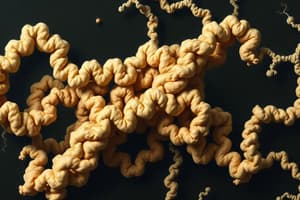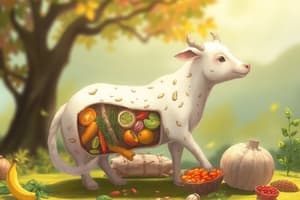Podcast
Questions and Answers
Which type of teeth primarily function in cutting food?
Which type of teeth primarily function in cutting food?
- Canines
- Incisors (correct)
- Premolars
- Molars
Tooth decay occurs when bases in the mouth erode the enamel.
Tooth decay occurs when bases in the mouth erode the enamel.
False (B)
Which organ secretes mucus to protect its lining from the damaging effects of hydrochloric acid?
Which organ secretes mucus to protect its lining from the damaging effects of hydrochloric acid?
stomach
Which of the following best describes the primary function of digestion in animals?
Which of the following best describes the primary function of digestion in animals?
Digestion is completed and nutrients are absorbed into the bloodstream in the ______.
Digestion is completed and nutrients are absorbed into the bloodstream in the ______.
Herbivores, carnivores, and omnivores all require the same types and amounts of nutrients to thrive.
Herbivores, carnivores, and omnivores all require the same types and amounts of nutrients to thrive.
Match the digestive fluid with its primary function:
Match the digestive fluid with its primary function:
What is the main function of villi in the small intestine?
What is the main function of villi in the small intestine?
Name the enzyme present in saliva that initiates the digestion of starch.
Name the enzyme present in saliva that initiates the digestion of starch.
The rhythmic contraction and relaxation of the esophagus that propels food towards the stomach is called ________.
The rhythmic contraction and relaxation of the esophagus that propels food towards the stomach is called ________.
The large intestine is primarily responsible for the digestion of food particles.
The large intestine is primarily responsible for the digestion of food particles.
What is the name of the first chamber in the stomach of a ruminant where grass is initially stored?
What is the name of the first chamber in the stomach of a ruminant where grass is initially stored?
Match each digestive organ with its primary function:
Match each digestive organ with its primary function:
Which of the following sequences correctly lists the processes in the human digestive system?
Which of the following sequences correctly lists the processes in the human digestive system?
Amoeba use temporary extensions of their cell membrane, called ______, to ingest food.
Amoeba use temporary extensions of their cell membrane, called ______, to ingest food.
Which process involves the removal of undigested waste from the body?
Which process involves the removal of undigested waste from the body?
How do animals obtain nutrition, considering plants and animals?
How do animals obtain nutrition, considering plants and animals?
The liver and pancreas are located near the stomach and small intestine. What is their main role?
The liver and pancreas are located near the stomach and small intestine. What is their main role?
Flashcards
Why do animals need nutrition?
Why do animals need nutrition?
Nutrients are needed for energy, growth, and essential life processes.
What is digestion?
What is digestion?
The breakdown of complex food into simpler substances for the body to use.
What is the alimentary canal?
What is the alimentary canal?
A tube from the mouth to the anus, responsible for breaking down and absorbing nutrients.
What are digestive glands?
What are digestive glands?
Signup and view all the flashcards
What is ingestion?
What is ingestion?
Signup and view all the flashcards
What is digestion?
What is digestion?
Signup and view all the flashcards
What is absorption?
What is absorption?
Signup and view all the flashcards
What are peristaltic movements?
What are peristaltic movements?
Signup and view all the flashcards
Incisors
Incisors
Signup and view all the flashcards
Canines
Canines
Signup and view all the flashcards
Premolars and Molars
Premolars and Molars
Signup and view all the flashcards
Stomach
Stomach
Signup and view all the flashcards
Small Intestine
Small Intestine
Signup and view all the flashcards
Bile
Bile
Signup and view all the flashcards
Villi
Villi
Signup and view all the flashcards
Large Intestine
Large Intestine
Signup and view all the flashcards
Ingestion
Ingestion
Signup and view all the flashcards
Digestion
Digestion
Signup and view all the flashcards
Study Notes
Nutritional Needs of Animals
- Animals need nutrition for energy, growth, and life processes.
- Nutrition includes nutrient intake, utilization, and waste elimination.
- Life processes: nutrition, respiration, transportation, and excretion.
- Life Processes are essential for survival.
- Foods convert into simpler compounds like glucose, amino acids, and fatty acids.
- Digestion simplifies complex food into usable substances.
- Plants produce their own food, while animals get it from other sources.
- Herbivores, carnivores, and others each play a unique role in the ecosystem.
- Energy consumption is crucial for bodily functions, even during rest.
Digestive Processes
- Food is broken down both physically and chemically.
- Physical breakdown involves actions like chewing.
- Chemical breakdown involves enzymes.
- Organisms use different feeding mechanisms like sucking or engulfing.
- The digestive system, also known as the gut tube, breaks down and absorbs nutrients.
- Organs help break down food and absorb nutrients.
The Digestive System
- The digestive system includes the alimentary canal and digestive glands.
- The alimentary canal runs from the mouth (buccal cavity) to the anus.
- The gut tube extends between the mouth and anus.
- Key parts: mouth, buccal cavity, esophagus, stomach, small intestine, large intestine, rectum, and anus.
Digestive Glands
- Digestive juices in the digestive tract aid digestion.
- Different glands use various enzymes for specific chemical reactions.
- Salivary glands are located in the mouth.
- The liver is close to the stomach and small intestine.
- The pancreas sits below the stomach, near the small intestine.
The Human Digestive System: A Detailed View
- The human digestive system is made of the alimentary canal and digestive glands.
- Processes include ingestion, digestion, absorption, assimilation, and egestion.
- Ingestion: taking food into the body.
- Digestion: breaking down food.
- Absorption: moving nutrients into the body.
- Assimilation: using nutrients.
- Egestion: removing waste products.
Mouth and Buccal Cavity
- The mouth performs ingestion, which is the intake of food.
- Saliva aids swallowing and starts digestion.
- Saliva includes amylase, an enzyme initiating starch digestion.
- The tongue mixes saliva with food, assisting in swallowing.
- Food travels down the esophagus through peristaltic movements.
- Peristaltic movements involve the contraction and relaxation of the esophagus walls.
- Teeth mechanically break down food.
- Teeth include incisors, canines, premolars, and molars.
- Incisors are for cutting.
- Canines are for tearing.
- Premolars and molars are for grinding food.
Tooth Decay
- Tooth enamel is the hardest substance in the body.
- Bacteria act on sugars, producing acids that erode enamel.
- Regular tooth brushing prevents decay.
The Stomach
- The stomach is a thick-walled, J-shaped bag.
- It receives food from the esophagus and continues digestion.
- The stomach secretes mucus, hydrochloric acid, and digestive juices.
- Mucus protects the stomach lining from acid.
- Hydrochloric acid kills bacteria and helps in digestion.
Small Intestine
- The small intestine is about 7.5 meters long.
- It receives secretions from the liver and pancreas for continued digestion.
- Bile juice from the liver aids in fat digestion.
- Complete food digestion occurs here.
- Absorption occurs here, with digested food entering the bloodstream.
- Nutrients are transported to cells throughout the body via the bloodstream.
Liver and Pancreas
- The liver secretes bile.
- Bile breaks down fats into smaller droplets.
- The pancreas secretes pancreatic juice.
- Pancreatic juices act on carbohydrates, fats, and proteins for further breakdown.
Absorption in the Small Intestine
- The inner walls of the small intestine have villi.
- Villi are finger-like projections increasing the surface area for absorption.
- Villi absorb nutrients into the bloodstream, distributing them throughout the body.
Large Intestine
- The large intestine is wider and shorter than the small intestine.
- It absorbs water and salts from undigested food.
- Waste forms feces, stored in the rectum before elimination through the anus.
Digestion in Grass-Eating Animals
- Ruminants swallow grass quickly, storing it in the rumen.
- Food is later regurgitated for thorough chewing.
- This process facilitates digestion in the ruminant stomach.
Ruminants and Their Unique Digestion
- Ruminants like cows possess a four-chamber stomach: rumen, reticulum, omasum, and abomasum.
- Grass is partially digested in the rumen, then brought back to the mouth for thorough chewing.
- Bacteria in the rumen aid in digesting cellulose, a complex carbohydrate in grass.
Feeding and Digestion in Amoeba
- Amoeba ingests food with pseudopodia, temporary extensions of its cell membrane.
- Food is trapped in a food vacuole, where enzymes break it down.
- Digested food is absorbed: undigested waste is expelled.
More Key Terms
- Ingestion: taking food in through the mouth.
- Digestion: breaking down food into simpler substances.
- Absorption: the gut absorbing food.
- Assimilation: utilizing nutrients within the body.
- Egestion: removing waste.
Review Questions from the Text
- The processes performed by the digestive system include digestion, absorption, assimilation, and egestion.
- Hydrochloric acid is produced in the stomach.
- Bile juice acts upon fats.
- Bread is an example of a carbohydrate, based on the text.
- The specific location for the start of protein digestion in mammals isn't provided in the text.
Studying That Suits You
Use AI to generate personalized quizzes and flashcards to suit your learning preferences.
Description
Animals need nutrition for energy, growth, and life processes, involving nutrient intake, utilization, and waste elimination. Digestion breaks down complex food into simpler substances for the body to use. Different organisms employ various feeding mechanisms for survival.




